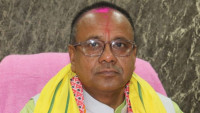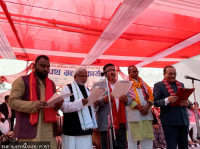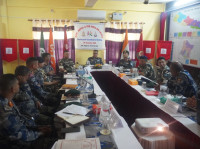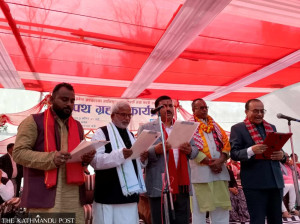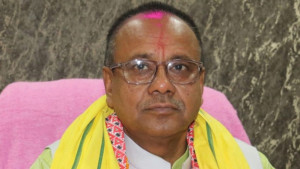Madhesh Province
50-year-old Tilawe bridge crumbles. Repairs uncertain
Locals worry transportation will suffer if repairs aren’t done before the rainy season.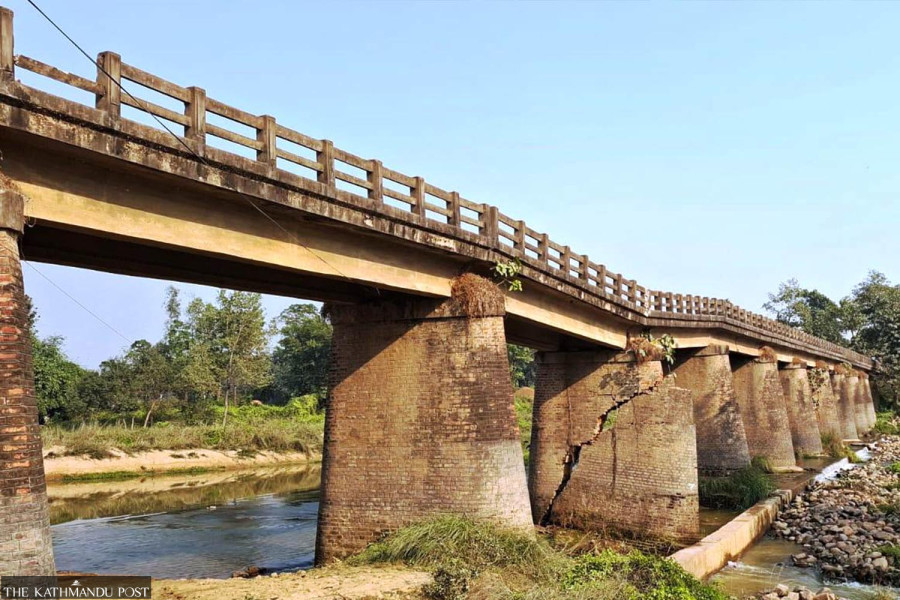
Bhusan Yadav
A bridge over the Tilawe river in Parsa district caved in as one of the bridge’s pillars broke four months ago. Repair on the damaged bridge along the Gandak irrigation canal is yet to begin, greatly inconveniencing local residents.
Ground Water Resources and Irrigation Development Division Office in Birgunj constructed a diversion road across the river to resume transportation after the bridge caved in. But the diversion is not in a good shape as it was built by piling up soil and pebbles. The locals complain that it is quite difficult to drive along the makeshift road.
Moreover, the local people are concerned about smooth transportation along the stretch during the rainy season.
“The bridge caved in four months ago. But the authorities have yet to initiate its repair or reconstruction. When water level sharply increases in the rainy season, the diversion becomes unusable. The government should take prompt decisions and initiate the reconstruction or repair work,” said Saroj Yadav, a resident of Parsagadhi Municipality. According to him, the people living in northern parts of Parsa have been greatly affected by the delay in repairing the bridge.
The road along the Gandak irrigation canal is an important road system in Parsa and Bara districts. The people of northern Parsa have been using the road to reach Birgunj, the district headquarters of Parsa, and the neighbouring Bara district.
Of late, traffic has increased significantly on the road along the Gandak canal after the Department of Roads blacktopped it a few months ago. Some vehicles have been using the road via Tilawe barrage after the bridge got damaged. Technicians at the barrage are concerned that vibration caused by the movement of heavy vehicles could adversely impact the barrage structure. They underscore the need for reconstructing or repairing the damaged bridge and resuming transportation.
It is still unclear when the reconstruction of the damaged bridge will begin. According to Manoj Patel, chief at the Ground Water Resources and Irrigation Development Division Office in Birgunj, the Department of Roads was informed immediately after the Tilawe bridge got damaged. “Officials at the department assured us of reconstructing the damaged bridge. But the work has not been initiated yet,” said Patel. “The budget is issued to the irrigation division office to repair the canal and restore the irrigation system. But the office has no budget to reconstruct or repair the bridge,” he added.
The Indian government constructed the canal, along with its bridges and supporting structures, in two phases between 1975 and 1976 as part of the Gandak Agreement, and later handed them over to Nepal. The Gandak irrigation canal and its bridges in Parsa and Bara are in a state of disrepair.
There are 22 small and big bridges spanning the canal across Parsa and Bara. Besides the Tilawe bridge, the Bangari bridge in Pheta Rural Municipality of Bara, the Sirsiya river bridge in Birgunj Metropolitan City in Parsa, and the Oriya river bridge in Jagarnathpur Rural Municipality in Parsa—are so dilapidated that they could collapse any moment.
The approach road running alongside the canal and the bridges on that road were built to handle only lightweight vehicles; the road has been used by the residents of all three districts as an alternative to the Postal Highway. The bridges have suffered severe damage due to a regular movement of heavy trucks, tippers, and buses loaded beyond capacity.
Although the federal government recently blacktopped this approach road from Rautahat to Parsa, no plans are in place to repair or replace the dilapidated bridges. After the upgrade, vehicular traffic has increased significantly on the approach road, putting more strain on the already fragile bridges.
The irrigation canal draws water from the Narayani (Gandak) barrage in Nawalparasi via Janakitola of Parsa and empties into the Bagmati river in Rautahat. The 81-km canal was designed to irrigate around 31,400 hectares of farmlands in Parsa, Bara and Rautahat districts.




 18.12°C Kathmandu
18.12°C Kathmandu
